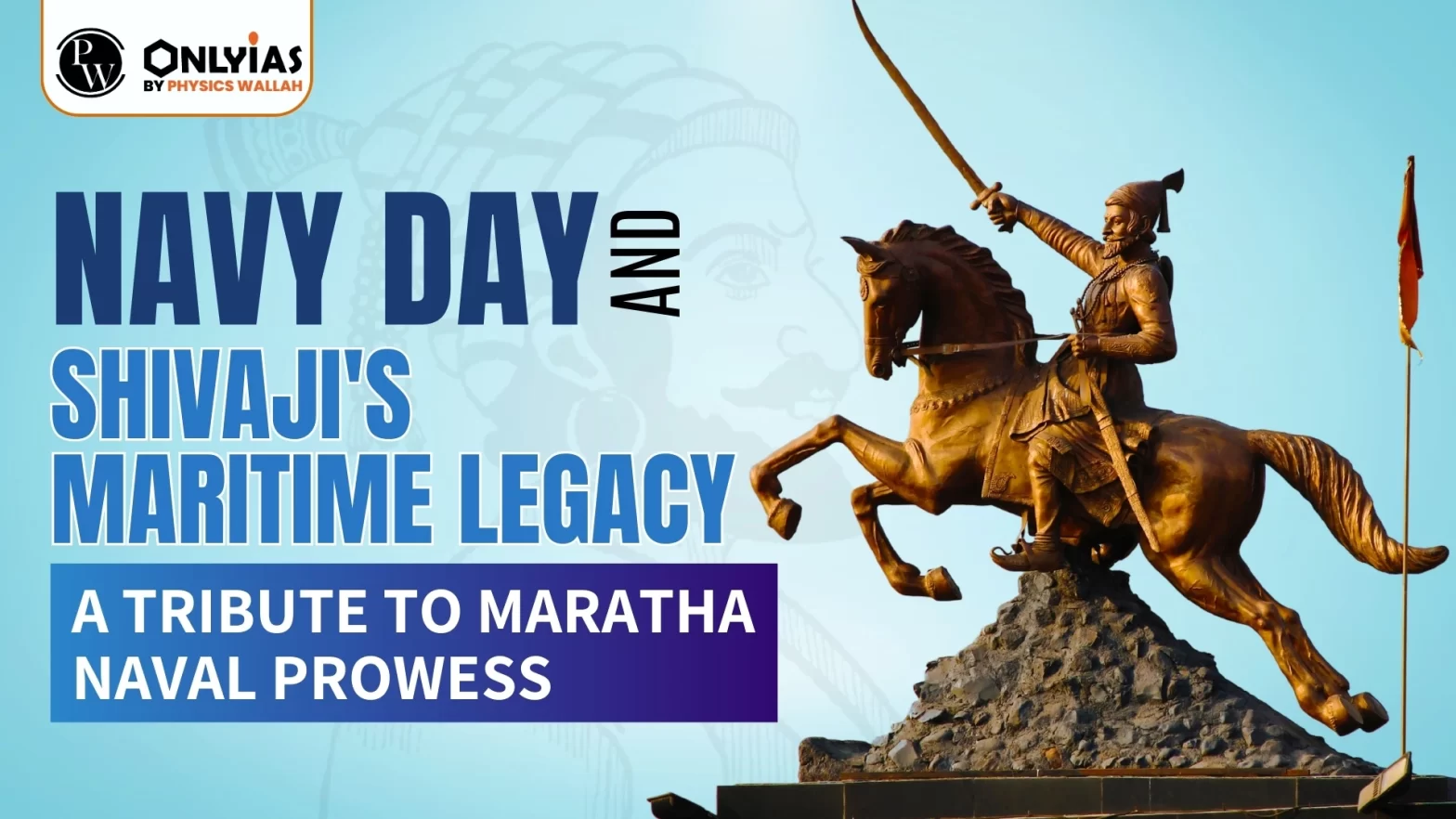Context: This article is based on an Editorial “Navy Day: As PM Modi praises Shivaji’s naval prowess, a look at the Maratha Navy” Which was published in the Indian Express. The Indian Prime Minister paid tributes to Chhatrapati Shivaji Maharaj on the occasion of Navy Day (December 4) and unveiled a grand statue of the 17th-century Maratha king at the coastal fort of Sindhugarh, Maharashtra.
- He announced that epaulets (ornamental shoulder pieces denoting rank) adorned by naval officers will soon carry the Chhatrapati Shivaji Maharaj emblem.
| Relevancy for Prelims: Indian Navy Day 2023, Chhatrapati Shivaji Maharaj, Operation Trident, 1971 Indo-Pak War, INS Shivaji and INS Angre.
Relevancy for Mains: Shivaji’s Maritime Legacy, Significance of Chhatrapati Shivaji Maharaj’s naval vision in shaping maritime defense in India, the limitations of the Maratha Navy, and its impact on subsequent naval strategies. |
Establishment of Maratha Navy by Shivaji
- Vision: His vision was based on his belief in ‘Jalameva yasya, balameva tasya’ (‘He who rules the seas is all powerful’).
- Decision to Establish a Navy: Shivaji’s empire reached the west coast after 1656-57 when his dominions touched Kalyan. In the same year, he decided to establish a navy.
- Reason for Navy Establishment: To protect his territory from the Siddis, and secure ports and merchant ships to ensure maritime trading, and bring in revenue and customs duty.
- Existence of the Maratha Navy: It came into existence between 1661 and 1663.
- It comprises 400-odd ships of various kinds and sizes. These included both larger battleships, and other vessels of varying shapes and purposes, such as the gurab, tarande, galbat, shibad, and pal.
Navy Day:
- The celebration of Indian Navy Day, on December 4 holds historical significance as it commemorates ‘Operation Trident‘ during the 1971 Indo-Pak War.
|
What were the strategic forts under Shivaji?
- Construction of Naval Forts: It started in 1653.
- Between 1653 and 1680, Shivaji ordered the construction of multiple naval forts.
- Vijaydurg, Sindhudurg, and Kolaba among key forts.
- For Strategic Purpose: These forts, many of them unconquered, were used for strategic purposes, to keep a watch on enemies approaching via the seas.
- Example: Vijaydurg was strategically located to keep an eye on enemies.
- Under His Control: North Konkan’s Kalyan and Bhiwandi, which were part of the Bijapur territory, came under Shivaji’s control by 1657.
- Even after Shivaji’s demise, the Maratha Navy was a formidable force, led by admirals such as Angre.
What were the naval successes and tactics employed by Shivaji?
- First Success: Successful raid on Basuru near Kundapura, in today’s Karnataka with 85 ships {as per BK Apte’s pioneering- A History of the Maratha Navy and Merchant Ships (1973)}.
- It showcased the Maratha Navy’s efficiency and success.
- Innovative Tactics: They performed innovative techniques in littoral waters.
- The Indian Navy Document: It states Shivaji realized the importance of having a secure coastline and protecting the western Konkan coastline from the attacks of Siddis’ [Afro-Indians allied with Deccani Sultans] fleet.
Also Read: Three Anti submarine Warfare Ships for Indian Navy Launched
What were the limitations of the Maratha Navy?
- Brown Water Navy: While Shivaji showed incredible military intelligence in developing a naval force, it focused only on countering regional threats, particularly the Siddis of Janjira.
- Inferior in Comparison with European Powers: Limited strategic objectives, not challenging European naval powers.
- After the decline of Portuguese power, the control of the high seas went to the British (on this basis the British built their empire). However, the Marathas, unfortunately, did not have the means to compete with these blue water policies.
- Example: Maratha ships paid taxes to the Portuguese while heading towards West Asia.
Shivaji’s Maritime Legacy and Recognition in Indian Navy
- Indian Navy’s New Ensign (Flag): Last year, the PM unveiled the Indian Navy’s new Ensign-based on the seal of Shivaji at the commissioning of aircraft carrier INS Vikrant in Kochi.
- Also the use of the octagonal design of the seal of Shivaji on the new Naval Ensign.
- Naming after Marathas Naval Commanders: The Indian Navy has named:
- Its training establishment in Lonavla as INS Shivaji.
- The shore-based logistics and administrative hub of the Western Naval Command, Mumbai, as INS Angre ( named after the celebrated Maratha naval commander Kanhoji Angre(1669-1729).
Also Read: Armed Forces Flag Day
Shivaji’s Maritime Legacy for Future Naval Strength
- Security: Securing Konkan coastline and trade routes.
- Foundation for Future Naval Power: Laying the foundation for future naval capabilities in India.
- Example: Indian Navy’s coastal and high seas defense influenced by Shivaji’s vision.
Conclusion:
Shivaji’s maritime legacy continues to shape the Indian Navy’s ethos, as evidenced by recognitions, symbols, and strategic considerations, reinforcing his enduring impact on the nation’s naval strength and coastal security.
![]() 6 Dec 2023
6 Dec 2023

